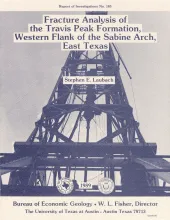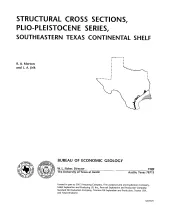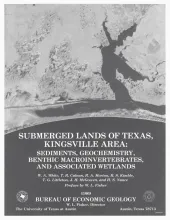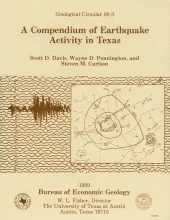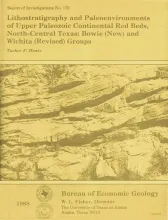Successful development of low-permeability-sandstone gas reservoirs depends on an understandingof their natural fracture patterns and on predictions of the orientation of horizontal stresses.This report describes the preliminary results of fracture analysis of the Lower Cretaceous TravisPeak Formation, a tabular sandstone and shale unit approximately 2,000 ft (610 m) thick thatproduces gas from low-permeability (less than 1 md) sandstone in much of East Texas. Depth to thetop of the formation ranges between 5,900 and 9,500 ft (1,798 and 2,895 m) in the study area.
These cross sections illustrate the regional structure and stratigraphy beneath the Texas continental shelf . The Plio-Pleistocene Series in the western Gulf Coast basin comprises a thick wedge of terrigenous clastic sediment that produces modest volumes of hydrocarbons from offshore leases along the outer shelf and upper slope. Sandstone reservoirs within this wedge have yielded more than 40 million bbl of oil and 2.5 Tcf of gas.
The State-owned submerged lands of Texas encompass almost 6,000 mi2 (15,540 km2). They lie below waters of the bay-estuary-lagoon system and the Gulf of Mexico and extend 10.3 mi (16.6 km) seaward from the Gulf shoreline (fig. 1). The importance of these lands and their resources to resident flora and fauna as well as to people is well known and documented; more than one-third of the state's population is concentrated within an area of the Coastal Zone that is only about one-sixteenth of the state's land area.
A comprehensive review of Texas earthquakes from 1847 to 1986 has revealed 106 earthquakes of magnitude 3 or greater; of these, 24 are earthquakes for which reports of damage are available, and 1 was responsible for a human fatality. All known reports on Texas seismicity are incorporated in this circular, including original "felt" (eyewitness) reports from contemporary newspapers and other sources.
Approximately 2,200 ft (670 m) of principally continental and paralic rocks of late Virgilian, Wolfcampian, and early Leonardian age (late Pennsylvanian and early Permian) are exposed in an area of about 4,950 mi2 (12,800 km2) between the Brazos and Red Rivers in North-Central Texas. The stratigraphic complexity of these strata has impeded internal correlation and mapping ever since the rocks were first described by W. F. Cummins in the late 19th century.


